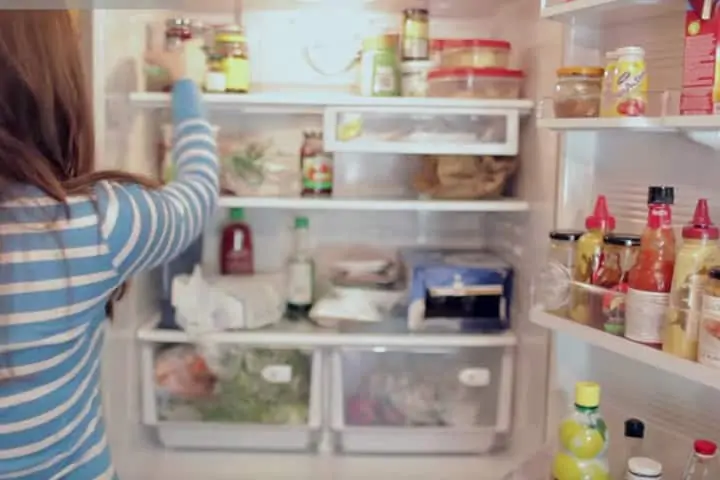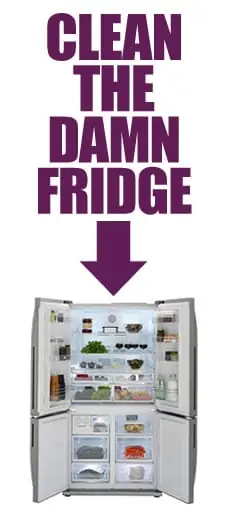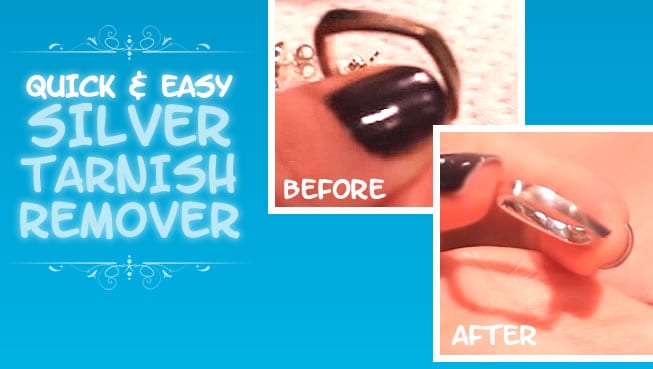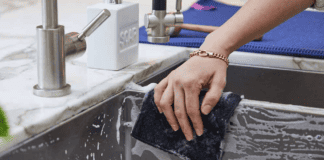Your refrigerator is one of the hardest working appliances in your home.
Often overlooked, it endures spills, stinky odors and overcrowding on a daily basis and never gets a break. A clean refrigerator helps keep food fresher and is less likely to have issues down the road. There are various tasks that should be done on a daily, weekly/monthly and quarterly basis to keep your refrigerator in tip top shape.
Daily Cleaning
It’s almost a no brainer that if you spill something, it should be cleaned up immediately. This includes putting things into the fridge in good condition as well. Wipe the lid of the pasta jar with a smear; catch the glob of jelly running down the side of the bottle… you get the picture. In doing so, you will prevent unnecessary food from becoming caked onto your fridge.
Another thing you should do regularly is check for spoilage and throw anything away that doesn’t look (or smell) good. If you have anything that may leak, put it on a rimmed plate (i.e. defrosting meat or a carton of berries) to prevent a mess before it happens.
Weekly/Monthly Cleaning
Wipe down the doors, including edges, and the top of the refrigerator with a microfiber cloth dampened with a mild dishwashing liquid and water. A must clean area to pay attention to are the areas around the handles that can have sticky fingerprints (especially from that PB&J sandwich last week).
Also, don’t forget to check out Maker’s Clean line of premium products. From microfiber cloths to the Maker’s Mop, they have a great line of high-quality products that will help you take your cleaning game to the next level!
If you have a stainless steel fridge, here’s a quick how-to on cleaning stainless steel:
Quarterly Cleaning
Depending how long it takes you to clean your fridge, you can use your discretion and decide whether you want to unplug the fridge to clean the inside. Keep in mind that if you chose to unplug it, it will take time to get back up to temperature. However, leaving the door open for too long will cause the fridge to work double time to keep it cold. The choice is yours! Either way, you’ll need to empty the fridge contents into a cooler or store it out of your way temporarily.
Step 1
Remove all glass shelves and crisper drawers and bring to room temperature before cleaning to prevent cracking when you wash them. A good suggestion would be to clean them in the bath tub since you have more room than in your kitchen sink.
Step 2
Wipe the inside of your fridge with a mixture of 2 tablespoons of baking soda and 1 quart hot water. Work from top to bottom to prevent dripping onto surfaces that are already clean. Pay special attention to the bottom crevices and back of the refrigerator where spills tend to migrate. Rinse it with a damp cloth and dry with a clean towel. Do not use soap, detergent or any abrasive cleaners (think ammonia or bleach) on the inside of the fridge since it can leave behind a fragrance that can be absorbed by food. For caked-on residue, let the baking soda solution soak for 10 minutes or until it starts to crack or soften then rinse with a damp cloth and dry with a clean towel.
Step 3
Soak shelves and bins in a solution of 2 tablespoons of baking soda for every quart of warm water. Do not put it in the dishwasher and make sure it’s been dried well before replacing.
Step 4
Put the food back into the refrigerator.
Step 5
Although you clean the door on a regular basis, it’s important to get the door seals occasionally to remove crumbs that have collected. The best way to clean a door seal is by using hot water and a mild dishwashing liquid. Wipe it with a soft sponge or microfiber cloth and dry thoroughly with a clean cloth. Make sure the seal fits properly when you put it back on since an improper fit can cause cold loss and temperature fluctuations.
Step 6
Starting from the top and working your way down, clean the exterior of the refrigerator. It is best to use hot water and a mild dishwashing detergent.
We’ve got tons of amazing tips and tricks on kitchen cleaning at Clean My Space. Check out How to Clean an Oven!
BONUS TIPS!
Check the Drip Pan
For some fridge models, there is a removable drip pan that collects condensation from the refrigerator. To clean, remove the grill from the bottom front of your refrigerator and locate the drip pan (usually found on top of the condenser coils). Drip pans can become moldy and gross over time so wearing gloves is recommended. Clean thoroughly after removing and apply a disinfectant. Dry and replace the drip pan and front grill. Always refer to the manufacturer’s instructions and follow accordingly.
Vacuum the Refrigerator Coils
Unplug the refrigerator and move it away from the wall carefully and slowly. If your fridge has coils on the back of the refrigerator, use the brush attachment to vacuum the coils. For hard to reach coils, i.e. if it’s located behind a vent or has a cover screwed on, you’ll need to use a long, narrow crevice attachment for your vacuum cleaner. Put the refrigerator back when done and don’t forget to plug it back in. Always refer to your owner’s manual for assistance.
So how do you keep your fridge smelling fresh?
Keep leftovers in airtight containers to prevent the spread of odors. To help eliminate odors, put a fridge deodorizer or a box of baking soda into your fridge to absorb any unsightly smells. You don’t want your butter to taste like fajita onions!
If you’re looking for more secrets, I’ve got way more than 10,000 hours of cleaning experience in both practice and theory, so I’m proud to introduce you to my secret 3 Wave Cleaning System—clean faster and more efficiently than you ever have before!
Looking for a BETTER & EASIER Way to Clean Your Home?
Cleaning Expert Melissa Maker is here to help with her game-changing 3 Wave Cleaning System that will help you clean your house faster and easier than you ever thought possible!



















[…] discover that they’re very soiled, you may soak them in a mixture of baking soda and water. Your resolution ought to have 2 tablespoons of baking soda per liter […]
Watched vacating house guests remove their food from their fridge which they left behind (to reimburse me for a vet bill they caused me to incur); suspect they intentionally left a 5 lb package of meat behind (as the wife was bipolar and I was never informed of this beforehand). After pulling the plug to have it removed months later – discovered the rotten meat and a foul smell, of course. There were pools of congealed blood in the bottom of the fridge and was told that it would be impossible to remove the stench around the seals. For a situation like this, your advice somehow does not seem like STRONG ENOUGH a measure? Your instructions were a little confusing too, regarding ammonia or bleach – were you saying to avoid these or offering examples of products to use in addition to warm soapy water?
Please please please can you do a video like the bedroom cleaning one but for the kitchen?????!!!!!!
I need the MOTIVATION!
pretty please?
how should u clean mold off the door seals? I have heard bleach, but I have also heard bleach ruins the seals. Can u use peroxode?
what can u use to disinfect the drip pans?
[…] Clean the Damn Fridge! 7 Jun, 2012 […]
Do you have tips on cleaning the washing machine?
Another ‘fridge “cleaning” tip is NOT to overfill the freezer! I found out the hard way ($200+ for repairman) that the defrosting coils (actually heating elements) need air circulation in order to work; lest they frost up, stop working & eventually “die”, needing to be replaced.